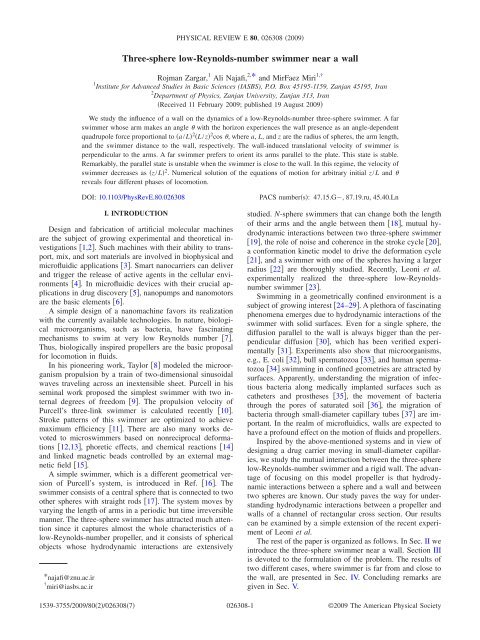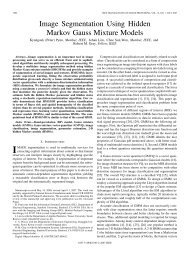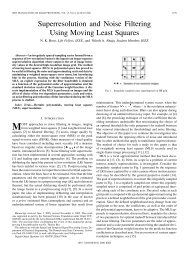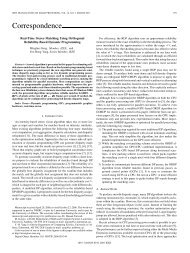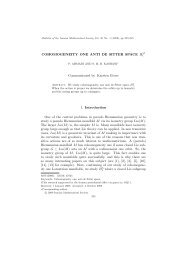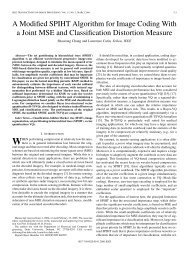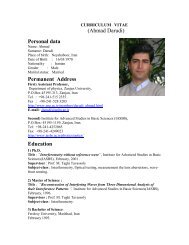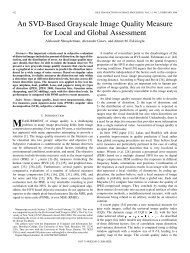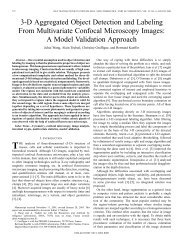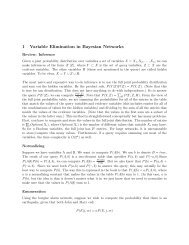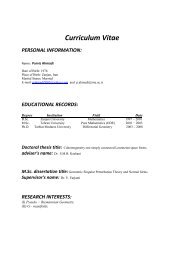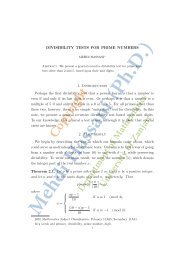Three-sphere low-Reynolds-number swimmer near a wall
Three-sphere low-Reynolds-number swimmer near a wall
Three-sphere low-Reynolds-number swimmer near a wall
- No tags were found...
Create successful ePaper yourself
Turn your PDF publications into a flip-book with our unique Google optimized e-Paper software.
PHYSICAL REVIEW E 80, 026308 2009<strong>Three</strong>-<strong>sphere</strong> <strong>low</strong>-<strong>Reynolds</strong>-<strong>number</strong> <strong>swimmer</strong> <strong>near</strong> a <strong>wall</strong>Rojman Zargar, 1 Ali Najafi, 2, * and MirFaez Miri1,†1 Institute for Advanced Studies in Basic Sciences (IASBS), P.O. Box 45195-1159, Zanjan 45195, Iran2 Department of Physics, Zanjan University, Zanjan 313, IranReceived 11 February 2009; published 19 August 2009We study the influence of a <strong>wall</strong> on the dynamics of a <strong>low</strong>-<strong>Reynolds</strong>-<strong>number</strong> three-<strong>sphere</strong> <strong>swimmer</strong>. A far<strong>swimmer</strong> whose arm makes an angle with the horizon experiences the <strong>wall</strong> presence as an angle-dependentquadrupole force proportional to a/L 2 L/z 2 cos , where a, L, and z are the radius of <strong>sphere</strong>s, the arm length,and the <strong>swimmer</strong> distance to the <strong>wall</strong>, respectively. The <strong>wall</strong>-induced translational velocity of <strong>swimmer</strong> isperpendicular to the arms. A far <strong>swimmer</strong> prefers to orient its arms parallel to the plate. This state is stable.Remarkably, the parallel state is unstable when the <strong>swimmer</strong> is close to the <strong>wall</strong>. In this regime, the velocity of<strong>swimmer</strong> decreases as z/L 2 . Numerical solution of the equations of motion for arbitrary initial z/L and reveals four different phases of locomotion.DOI: 10.1103/PhysRevE.80.026308I. INTRODUCTIONDesign and fabrication of artificial molecular machinesare the subject of growing experimental and theoretical investigations1,2. Such machines with their ability to transport,mix, and sort materials are involved in biophysical andmicrofluidic applications 3. Smart nanocarriers can deliverand trigger the release of active agents in the cellular environments4. In microfluidic devices with their crucial applicationsin drug discovery 5, nanopumps and nanomotorsare the basic elements 6.A simple design of a nanomachine favors its realizationwith the currently available technologies. In nature, biologicalmicroorganisms, such as bacteria, have fascinatingmechanisms to swim at very <strong>low</strong> <strong>Reynolds</strong> <strong>number</strong> 7.Thus, biologically inspired propellers are the basic proposalfor locomotion in fluids.In his pioneering work, Taylor 8 modeled the microorganismpropulsion by a train of two-dimensional sinusoidalwaves traveling across an inextensible sheet. Purcell in hisseminal work proposed the simplest <strong>swimmer</strong> with two internaldegrees of freedom 9. The propulsion velocity ofPurcell’s three-link <strong>swimmer</strong> is calculated recently 10.Stroke patterns of this <strong>swimmer</strong> are optimized to achievemaximum efficiency 11. There are also many works devotedto micro<strong>swimmer</strong>s based on nonreciprocal deformations12,13, phoretic effects, and chemical reactions 14and linked magnetic beads controlled by an external magneticfield 15.A simple <strong>swimmer</strong>, which is a different geometrical versionof Purcell’s system, is introduced in Ref. 16. The<strong>swimmer</strong> consists of a central <strong>sphere</strong> that is connected to twoother <strong>sphere</strong>s with straight rods 17. The system moves byvarying the length of arms in a periodic but time irreversiblemanner. The three-<strong>sphere</strong> <strong>swimmer</strong> has attracted much attentionsince it captures almost the whole characteristics of a<strong>low</strong>-<strong>Reynolds</strong>-<strong>number</strong> propeller, and it consists of sphericalobjects whose hydrodynamic interactions are extensively*najafi@znu.ac.ir† miri@iasbs.ac.irPACS <strong>number</strong>s: 47.15.G, 87.19.ru, 45.40.Lnstudied. N-<strong>sphere</strong> <strong>swimmer</strong>s that can change both the lengthof their arms and the angle between them 18, mutual hydrodynamicinteractions between two three-<strong>sphere</strong> <strong>swimmer</strong>19, the role of noise and coherence in the stroke cycle 20,a conformation kinetic model to drive the deformation cycle21, and a <strong>swimmer</strong> with one of the <strong>sphere</strong>s having a largerradius 22 are thoroughly studied. Recently, Leoni et al.experimentally realized the three-<strong>sphere</strong> <strong>low</strong>-<strong>Reynolds</strong><strong>number</strong><strong>swimmer</strong> 23.Swimming in a geometrically confined environment is asubject of growing interest 24–29. A plethora of fascinatingphenomena emerges due to hydrodynamic interactions of the<strong>swimmer</strong> with solid surfaces. Even for a single <strong>sphere</strong>, thediffusion parallel to the <strong>wall</strong> is always bigger than the perpendiculardiffusion 30, which has been verified experimentally31. Experiments also show that microorganisms,e.g., E. coli 32, bull spermatozoa 33, and human spermatozoa34 swimming in confined geometries are attracted bysurfaces. Apparently, understanding the migration of infectiousbacteria along medically implanted surfaces such ascatheters and prostheses 35, the movement of bacteriathrough the pores of saturated soil 36, the migration ofbacteria through small-diameter capillary tubes 37 are important.In the realm of microfluidics, <strong>wall</strong>s are expected tohave a profound effect on the motion of fluids and propellers.Inspired by the above-mentioned systems and in view ofdesigning a drug carrier moving in small-diameter capillaries,we study the mutual interaction between the three-<strong>sphere</strong><strong>low</strong>-<strong>Reynolds</strong>-<strong>number</strong> <strong>swimmer</strong> and a rigid <strong>wall</strong>. The advantageof focusing on this model propeller is that hydrodynamicinteractions between a <strong>sphere</strong> and a <strong>wall</strong> and betweentwo <strong>sphere</strong>s are known. Our study paves the way for understandinghydrodynamic interactions between a propeller and<strong>wall</strong>s of a channel of rectangular cross section. Our resultscan be examined by a simple extension of the recent experimentof Leoni et al.The rest of the paper is organized as fol<strong>low</strong>s. In Sec. II weintroduce the three-<strong>sphere</strong> <strong>swimmer</strong> <strong>near</strong> a <strong>wall</strong>. Section IIIis devoted to the formulation of the problem. The results oftwo different cases, where <strong>swimmer</strong> is far from and close tothe <strong>wall</strong>, are presented in Sec. IV. Concluding remarks aregiven in Sec. V.1539-3755/2009/802/0263087026308-1©2009 The American Physical Society
ZARGAR, NAJAFI, AND MIRIg^n ^th2a3II. MODEL: A THREE-SPHERE SWIMMERNEAR A WALLTo quantify the relative importance of the inertial andfrictional effects, <strong>Reynolds</strong> has introduced a dimensionless<strong>number</strong>. The <strong>Reynolds</strong> <strong>number</strong> R in terms of typical lengthscale l, typical velocity v, fluid density , and fluid viscosity, which are characteristics of the f<strong>low</strong>, is R=vl/. For anartificial propeller swimming in water, l1–10 m, v1–10 m/s, 1000 kg/m 3 , and 10 −3 Pa s; thus,R10 −6 –10 −4 is quite <strong>low</strong>.Propulsive motion in the highly viscous conditions, wherethe viscous effects dominate over the inertia effects, is not atrivial task 9. Under these conditions, any swimmingmechanism should involve a nonreciprocal cyclic motion.The nonreciprocal motion breaks the time-reversal symmetryand is of prime importance in swimming.Figure 1 shows a schematic view of a simple three-<strong>sphere</strong><strong>swimmer</strong> moving in a fluid medium bounded by a <strong>wall</strong>. The<strong>swimmer</strong> consists of three <strong>sphere</strong>s linked by two arms ofnegligible diameter. The length of arms denoted by ht andgt varies in a nonreciprocal manner to have a net displacement.We use the internal deformation space h,g to draw asimple picture of the possible swimming mechanisms. Anyclosed path in this space involves a sequence of body deformations,which propels the system. In particular, a simpleelliptic path in this space is a periodic variation in the armlengths, with a constant phase difference between the deformationsof two arms.x i and ẋ i are the position vector and velocity of the ith<strong>sphere</strong> i=1,2,3, respectively, that characterize the spaceconfiguration and dynamical behavior of the three-<strong>sphere</strong>system. Because of the symmetry considerations and with noloss of generality, we analyze the motion of <strong>swimmer</strong> in atwo-dimensional space x,z see Fig. 1. In the fol<strong>low</strong>ing,we first set up <strong>low</strong>-<strong>Reynolds</strong>-<strong>number</strong> hydrodynamic descriptionof the system and then solve the equations of motion.III. HYDRODYNAMIC INTERACTIONS BETWEENTHE SWIMMER AND WALLStokes equation describes the fluid motion at zero <strong>Reynolds</strong><strong>number</strong>. Denoting the fluid velocity field by ur, theh(t)θg(t)1 2FIG. 1. Color online Schematic view of a three-<strong>sphere</strong> <strong>swimmer</strong><strong>near</strong> a <strong>wall</strong>. The unit vector tˆ shows the arm direction. Top left:an admissible nonreciprocal motion in the h,g space.zzxpressure by pr, and the force density acting on the fluid byfr, the Stokes equation reads as − 2 ur+pr=fr30. The conservation of mass for the incompressible fluidcan be expressed as ·ur=0. The velocity field is alsosubject to a no-slip boundary condition on rigid surfaces.One of the elementary solutions to the Stokes equation isthe velocity field of a point force fr=br−r 0 embeddedin the infinite space and this solution is called Stokeslet orOseen-Burgers tensor. The velocity field of the Stokeslet canbe written as ur=Gr−r 0 ·b, where the free space Green’sfunction of the Stokes equation reads asG F r − r 0 = 18 x+ x x x 3 , 1here x=r−r 0 and ,=1,2,3.In 1971, Blake obtained the velocity field due to a pointforce in the vicinity of a stationary plane boundary 38.Since the no-slip condition should be satisfied on the plane,the influence of the boundary on the f<strong>low</strong> is deep. Assumingthat the <strong>wall</strong> is located at z=0 and the point force resides inr 0 , the fol<strong>low</strong>ing form for the Green’s function can be writtenasG B r − r 0 = 18 xPHYSICAL REVIEW E 80, 026308 2009+2z 0 2 1−2 z + x x x 3 − R + R R R 3R 3 − 3R R R 5 −2z 0 1−2 z R zR 3 − R R 3 z + R R 3 z − 3R R R zR 5 . 2Here x=r−r 0 , z 0 =ẑ·r 0 , R=r−r i i0 , and r 0 represents the imagepoint of r 0 with respect to the <strong>wall</strong>.Let us assume that a collection of N spherical objects aremoving inside the fluid. We denote by f i the hydrodynamicforce acting on the ith <strong>sphere</strong> moving with velocity v i . Theforce and velocities of <strong>sphere</strong>s obey the equationsNv i = M ij · f j ,3j=1where the mobility tensors M ij express the response of theith <strong>sphere</strong> to the force acting on the jth <strong>sphere</strong>. We can useFaxén’s theorem for spherical objects with radius a to expressthe mobility tensor in terms of the Green’s function ofStokes equation 30,39,M ij =1+ a26 r21+ a2i 6 r2G rji ,r j . 4If we assume that the radius a is smaller than the distancebetween <strong>sphere</strong>s then M ij =G r i ,r j up to the second orderin a. It fol<strong>low</strong>s immediately that the Green’s functionG B r i ,r j introduced by Blake is the first approximation forthe mobility tensor of <strong>sphere</strong>s moving in a fluid bounded bya <strong>wall</strong>.Another point to mention is the self-mobility of a <strong>sphere</strong>moving <strong>near</strong> a <strong>wall</strong>. Assuming that the distance z between<strong>sphere</strong> and <strong>wall</strong> is greater than the <strong>sphere</strong> radius a, the componentsof self-mobility tensor are 30,39026308-2
ZARGAR, NAJAFI, AND MIRIOur work can be extended in many directions. Our resultscan be examined by a simple extension of the recent experimentof Leoni et al. 23. Swimming in a complex geometry,e.g., a microchannel of rectangular or circular cross section isof immediate interest. Inspired by the colonies of swimmingbacteria <strong>near</strong> biological membranes, we are investigatingmany propellers adjacent to a <strong>wall</strong>.APPENDIX: HYDRODYNAMIC MOBILITY TENSORSThe hydrodynamic mobility tensors appearing in Eq. 6areM xx ij = 11 R 38 1 r − 1 R + x i − x j 2 1 r 3 − 1 R 3 +2z j2− 3x i − x j 2R 5 −2z j z i + z j R 3− 3x i − x j 2 z i + z j R 5 ,M xz ij =8 1 x i − x j z i − z j r 3 − x i − x j z i + z j R 3+6z j2 x i − x j z i + z j R 5+2z j x i − x j R 3 − 3x i − x j z i + z j 2R 5 ,M zx ij =8 1 x i − x j z i − z j r 3 − x i − x j z i + z j R 3M zz ij = 1−6z j2 x i − x j z i + z j R 5+2z j x i − x j R 3 + 3x i − x j z i + z j 2R 5 ,r 3 − z i + z j 2R 3 −2z2 1 jR 38 1 r − 1 R + z i − z j 2 +2z j z i + z j − 3z i + z j 2R 5R 3 − 3z i + z j 3R 5 ,where r 2 =x i −x j 2 +z i −z j 2 and R 2 =x i −x j 2 +z i +z j 2 .We definePHYSICAL REVIEW E 80, 026308 2009S 1 = M 12 + M 21 − M 11 − M 22 ,S 2 = M 13 + M 21 − M 11 − M 23 ,S 3 = M 12 + M 31 − M 11 − M 32 ,S 4 = M 13 + M 31 − M 11 − M 33 .Now the matrix elements appearing in Eq. 11 can be introducedasa 11 = − cos S 1 xx − sin S 1 zx ,a 12 = − cos S 1 xz − sin S 1 zz ,a 13 = − cos S 2 xx − sin S 2 zx ,a 14 = − cos S 2 xz − sin S 2 zz ,a 21 = cos S 3 xx + sin S 3 zx ,a 22 = cos S 3 xz + sin S 3 zz ,a 23 = cos S 4 xx + sin S 4 zx ,a 24 = cos S 4 xz + sin S 4 zz ,a 31 = cos hS 1 zx + gS 3 zx − sin hS 1 xx + gS 3 xx ,a 32 = cos hS 1 zz + gS 3 zz − sin hS 1 xz + gS 3 xz ,a 33 = cos hS 2 zx + gS 4 zx − sin hS 2 xx + gS 4 xx ,a 34 = cos hS 2 zz + gS 4 zz − sin hS 2 xz + gS 4 xz ,a 41 = g sin ,a 42 =−g cos ,a 43 =−h sin ,a 44 = h cos .1 E. R. Kay, D. A. Leigh, and F. Zerbetto, Angew. Chem., Int.Ed. 46,722007; K. Kinbara and T. Aida, Chem. Rev. Washington,D.C. 105, 1377 2005.2 J. P. Sauvage and V. Amendola, Molecular Machines and MotorsSpringer-Verlag, Berlin, 2001.3 V. Balzani et al., Angew. Chem., Int. Ed. 39, 3348 2000.4 S. H. Kim, J. H. Jeong, S. H. Lee, S. W. Kim, and T. G. Park,J. Controlled Release 129, 107 2008.5 P. S. Dittrich and A. Manz, Nat. Rev. Drug Discovery 5, 2102006.6 H. Bruus, Theoretical Microfluidics Oxford University Press,Oxford, 2008.7 H. C. Berg, E. coli in Motion Springer, New York, 2004.8 G. Taylor, Proc. R. Soc. London, Ser. A 209, 447 1951.9 E. M. Purcell, Am. J. Phys. 45, 31977.10 L. E. Becker, S. A. Koehler, and H. A. Stone, J. Fluid Mech.490, 152003.11 D. Tam and A. E. Hosoi, Phys. Rev. Lett. 98, 068105 2007.12 J. E. Avron, O. Gat, and O. Kenneth, Phys. Rev. Lett. 93,186001 2004; J. E. Avron, O. Kenneth, and D. H. Oaknin,026308-6
THREE-SPHERE LOW-REYNOLDS-NUMBER SWIMMER NEAR…PHYSICAL REVIEW E 80, 026308 2009New J. Phys. 7, 234 2005.13 B. U. Felderhof, Phys. Fluids 18, 063101 2006.14 W. F. Paxton et al., Angew. Chem., Int. Ed. 45, 5420 2006; J.Am. Chem. Soc. 126, 13424 2004; S. Fournier-Bidoz et al.,Chem. Commun. Cambridge 2005, 441 2005; N.Manoand A. Heller, J. Am. Chem. Soc. 127, 11574 2005; R.Golestanian,T. B. Liverpool, and A. Ajdari, Phys. Rev. Lett. 94,220801 2005; J. R. Howse, R. A. L. Jones, A. J. Ryan, T.Gough, R. Vafabakhsh, and R. Golestanian, ibid. 99, 0481022007; G. Rückner and R. Kapral, ibid. 98, 150603 2007.15 R. Dreyfus, J. Baudry, M. L. Roper, M. Fermigier, H. A.Stone, and J. Bibette, Nature London 437, 862 2005; E.Gauger and H. Stark, Phys. Rev. E 74, 021907 2006; E.M.Gauger, M. T. Downton, and H. Stark, Eur. Phys. J. E 28, 2312009.16 A. Najafi and R. Golestanian, Phys. Rev. E 69, 062901 2004.17 Note that a <strong>swimmer</strong> with two rigid <strong>sphere</strong>s connected by o<strong>near</strong>m has one internal degree of freedom and cannot make nettranslational progress. As pointed out in Ref. 12, the nettranslational motion is possible if two <strong>sphere</strong>s change theirvolumes as well as their distance.18 D. J. Earl et al., J. Chem. Phys. 126, 064703 2007.19 C. M. Pooley, G. P. Alexander, and J. M. Yeomans, Phys. Rev.Lett. 99, 228103 2007; G. P. Alexander, C. M. Pooley, and J.M. Yeomans, Phys. Rev. E 78, 045302R 2008.20 R. Golestanian and A. Ajdari, Phys. Rev. E 77, 036308 2008.21 R. Golestanian and A. Ajdari, Phys. Rev. Lett. 100, 0381012008.22 R. Golestanian, Eur. Phys. J. E 25, 12008.23 M. Leoni, J. Kotar, B. Bassetti, P. Cicuta, and M. C. Lagomarsino,Soft Matter 5, 472 2009.24 H. H. Wensink and H. Löwen, Phys. Rev. E 78, 0314092008; S. van Teeffelen and H. Löwen, ibid. 78, 020101R2008.25 C. Sendner and R. R. Netz, EPL 79, 58004 2007.26 J. P. Hernandez-Ortiz, C. G. Stoltz, and M. D. Graham, Phys.Rev. Lett. 95, 204501 2005.27 P. Tierno, R. Golestanian, I. Pagonabarraga, and F. Sagues,Phys. Rev. Lett. 101, 218304 2008.28 R. M. Harshey, Annu. Rev. Microbiol. 57, 249 2003.29 P. D. Frymier, R. M. Ford, H. C. Berg, and P. T. Cummings,Proc. Natl. Acad. Sci. U.S.A. 92, 6195 1995.30 J. Happel and H. Brenner, Low <strong>Reynolds</strong> Number HydrodynamicsNoordhoff, Leyden, 1973.31 A. Pralle et al., Appl. Phys. A: Mater. Sci. Process. 66, S711998.32 A. P. Berke, L. Turner, H. C. Berg, and E. Lauga, Phys. Rev.Lett. 101, 038102 2008.33 L. Rothschild, Nature London 198, 1221 1963.34 H. Winet, G. S. Bernstein, and J. Head, J. Reprod. Fertil. 70,511 1984.35 G. Harkes, J. Dankert, and J. Feijen, Appl. Environ. Microbiol.58, 1500 1992.36 J. T. Gannon, V. B. Manilal, and M. Alexander, Appl. Environ.Microbiol. 57, 190 1991; R. E. Martin, E. J. Bouwer, and L.M. Hanna, Environ. Sci. Technol. 26, 1053 1992.37 H. C. Berg and L. Turner, Biophys. J. 58, 919 1990.38 J. R. Blake, Proc. Cambridge Philos. Soc. 70, 303 1971.39 Y. W. Kim and R. R. Netz, J. Chem. Phys. 124, 1147092006.026308-7


